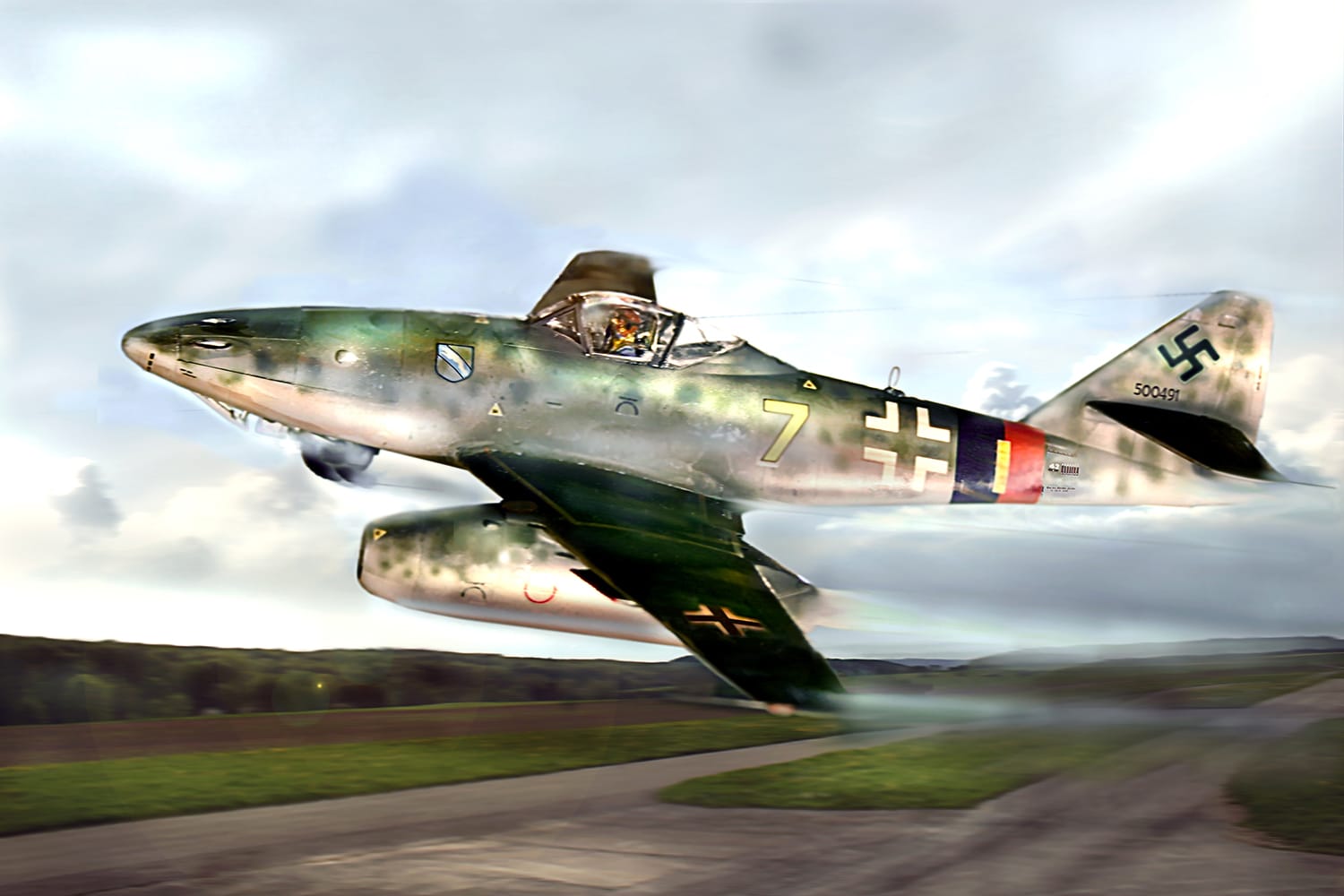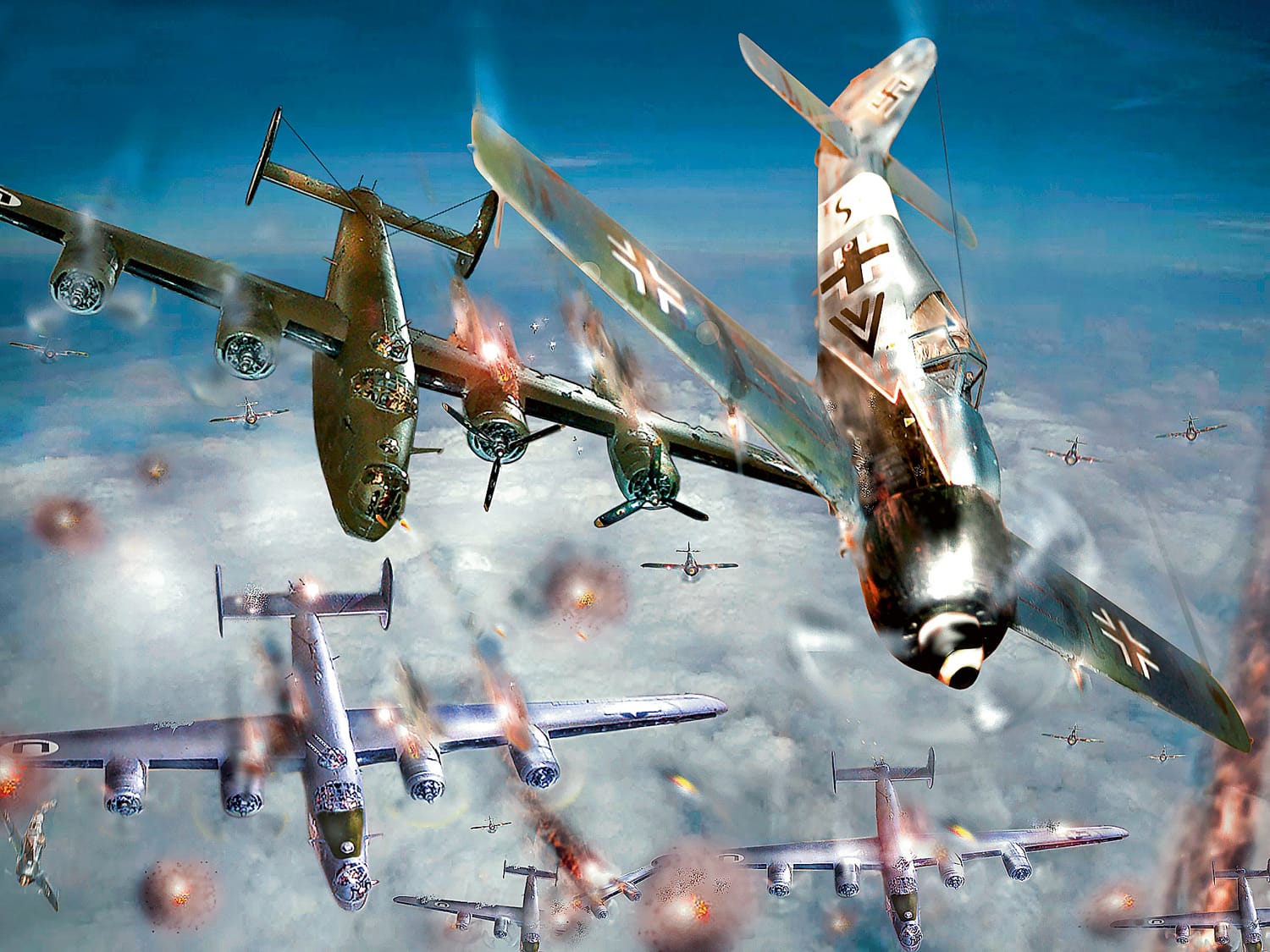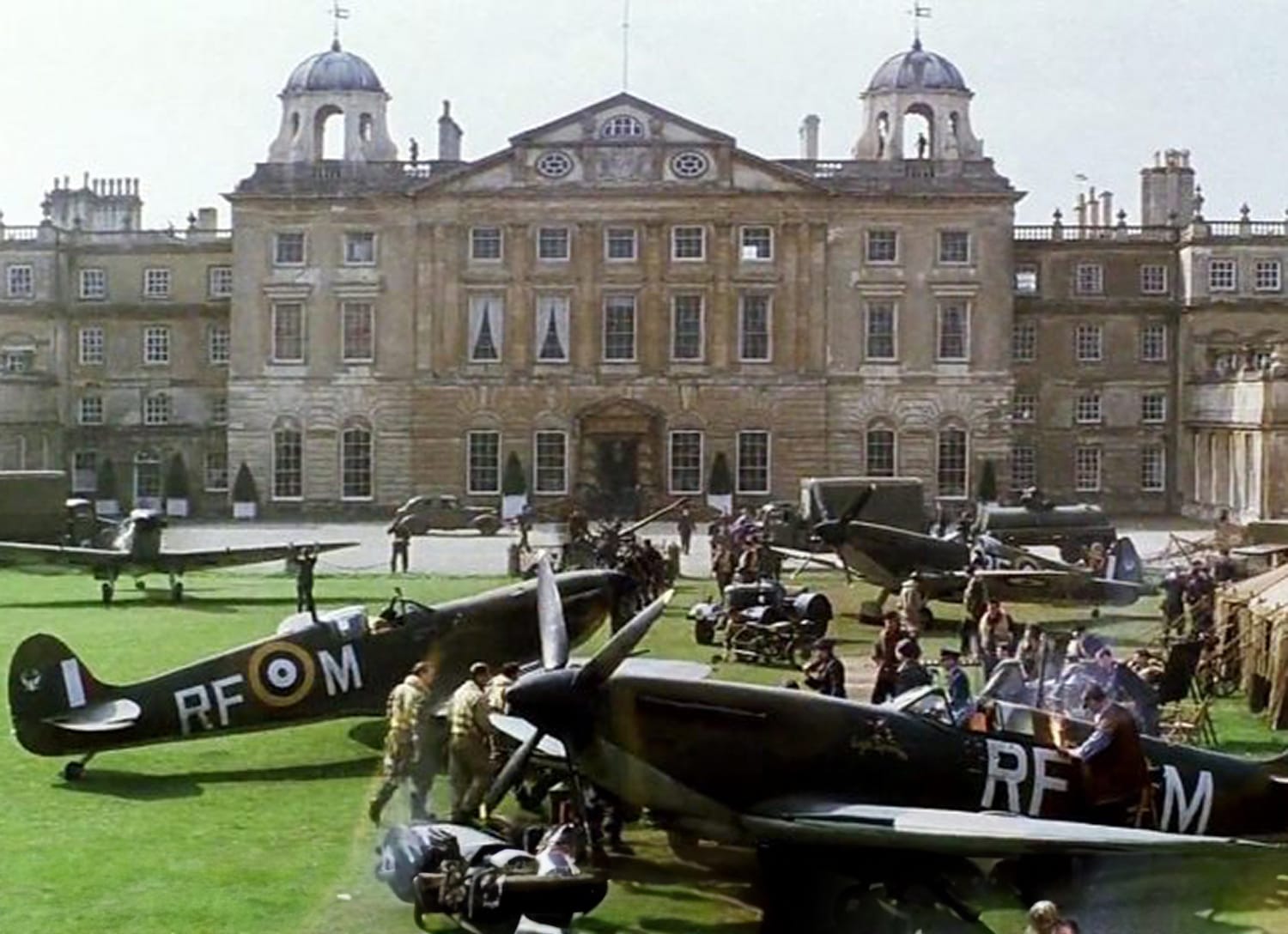Messerschmitt Me 262 – Germany’s last trump card in her air space above ruins
Me 262 – bomber or fighter
23rd May 1944: “Mein Führer, of course, even a child can see that it’s a fighter, not a bomber!” Generalluftzeugmeister Erhard Milch lost his nerve after a blistering dressing down by Adolf Hitler—and afterwards his position as well.
On the morning of 18th July 1942 the first Me 262 jet fighter to fly purely with jet propulsion took off from the runway of Leipheim airfield, piloted by Flugkapitän Fritz Wendel. It was indicative of the arbitrariness of the decision-making process within the Reich Air Ministry, that Adolf Galland who, in his capacity as General der Jagdflieger, bore the responsibility for the planning and provision of future fighter operations, knew absolutely nothing of this jet fighter’s development until the beginning of 1942. And even then he was only drip-fed information on its progress, until finally, on 22nd May 1943,he himself flew the fourth prototype. The words a deeply impressed Galland uttered after the flight, have since acquired near mythical status: “It felt like an angel was pushing!”
Galland’s enthusiasm for the potential of the Me 262 was such that he vehemently proposed they halt the production of the Messerschmitt Bf 109, to allow Messerschmitt to concentrate solely on the production of the new model. First of all he convinced Generalfeldmarschall Erhard Milch who, as Generalluftzeugmeister, was in charge of the development and organisation of the Luftwaffe’s armament production. Then he went to see Göring, the Luftwaffe Commander-in-Chief. This was how the former’s report ended:
“The almost unbelievable technical superiority of this aircraft will prove the key to deciding the battle for air supremacy over the Reich and later at the Fronts in our favour, despite our own numerical inferiority. No effort should be spared, no risk shunned, in immediately preparing the model for a full-scale production launch as soon as possible. Instead of one Me 262 we could dispense with two or three Me 109s for the air defences, should production requirements so dictate.”
Therefore, instead of following the usual Luftwaffe prescription of extensive preliminary testing to iron out a new model’s teething problems before going into full-scale production, Galland urged that the first 100 aircraft be tested and fine-tuned on operations. Although that of course entailed risks with the potential for casualties in accidents which would otherwise have been avoidable, failure to begin full-scale production quickly would exact a far higher toll on his fighter pilots, since the losses of his men in air combat at the time would continue undiminished due to the imbalance between the sides, which then remained both technical and numerical.
Reichsmarschall Göring was impressed by Galland’s enthusiasm and promised to obtain the necessary permission for the large-scale production of the jet fighter, something which would be little more than a formality. Knowing the situation in the air, Galland was in no doubt that Göring would receive such permission.
Nevertheless, there was one man in Germany who was firmly convinced that his “genius as a commander” put him head and shoulders above all other so-called military experts. His expertise had indeed to some extent been acquired in remarkable detail. However, he applied it so subjectively and increasingly as a result of wishful thinking that he grossly overrated his own ability. But at the time his word was law in Germany.
Hitler’s misconception: the “retaliatory bolt ‘blitz’ bombers”
Adolf Hitler rejected any suggestion of full-scale production from the outset, and would not be unduly rushed. The Führer became more and more driven by a desire for revenge. For him, the capacity to strike back was much more important than equipping his Luftwaffe with a fighter aircraft which was capable of defending the airspace of the Reich effectively against the increasing ferocity of the allied bomb attacks. As early as February 1943 he had insisted that every new fighter type to be produced should be fully capable of functioning as a fighter bomber. Hitler was not a great believer in defensive measures. Attack was his maxim. With tanks and bombs…
On 26th November 1943, when Hitler was given a demonstration of the new jet’s capabilities, he spontaneously, although perhaps not surprisingly, put to Hermann Goring what was probably the inevitable question: “Can this aircraft carry bombs?” Göring had discussed that very point previously with the designer and, therefore, allowed Willy Messerschmitt to answer.
“Indeed, mein Führer, in principle yes.”
Those were the words Hitler had been hoping to hear. “For years I have been asking the Luftwaffe for the fast bomber, one which could reach its target in safety, regardless of the enemy fighter defences. That, ultimately, is the ‘Blitzbomber’ [Bolt bomber], for you! Of course, none of you ever thought of it!”
As far as Hitler was concerned this was the end of the matter. He expected his wishes to be carried out and the Me 262 to be modified into its role of a “revenge bolt bomber”: a role for which the aircraft was totally unsuitable. The bomb load robbed the Me 262 completely of its decisive speed advantage, and it was, therefore, vulnerable to an air attack. Even with bombs on board it would still be too fast for accurate bomb aiming, especially so since the pilot was seated over the wings and at altitude had virtually no sight of ground targets. In descending approach angle, —let alone a dive—the maximum permissible speed would be exceeded in an instant. The jet would then be uncontrollable and sooner or later the wings would tear away. As for low level flight, they might as well tow a fuel tanker behind it for the quantity of fuel the jet fighter would expend while so doing.
Generalluftzeugmeister Erhard Milch lost his nerve after a blistering dressing down by Adolf Hitler—and afterwards his position as well.
The Luftwaffe’s most urgent number one priority at this time was for a superior fighter with which to recapture the lost air supremacy over Germany. The German piston-engined equipped fighter units were fighting desperate battles against a local twenty-fold enemy air superiority, and overall the disparity was even greater. They did so, moreover, with pilots who were being fast-tracked in a training process which was becoming less and less adequate, since there were fewer and fewer instructors available, and less and less fuel for training flights. They fought tenaciously, but many failed to survive even their maiden mission. The more experienced fighters flew tirelessly, but their numbers were dwindling.
And there it was – a fighter aircraft capable of a fantastic 540 mph at 20,000 feet (19.685 ft, 870 km/hat 6.000 m altitude) – and, therefore, 95 mph (some 150 km/h) faster than the fastest allied fighter, powerfully armed and able to simply leave an enemy fighter standing, even when attacked in superior number. A burst of fire from the four 30 mm cannon would be sufficient to completely sever a four-engined B-17’s wing, and each of the Me 262’s 24 R4M rockets (available later) could blow any enemy aircraft to smithereens with a single hit. One salvo of these rockets fired into the midst of a large bomber formation, whose aircraft would generally be flying in close formation so as to concentrate their defensive fire, had a devastating effect. The destructive outcome surpassed all expectations.
There it stood – in alien guise, as a bomber! The bomber wings reluctantly had to retrain their bomber pilots to fly the Me 262, laboriously build up the complex logistics and construct expensive concrete runways in France. All this to repel the invasion! When the invasion subsequently took place, not a single “Blitzbomber” was operational. When the runways were eventually ready, they were captured by the enemy. Furthermore, the former bomber pilots were not as skilled in the tactics required for fighter against fighter air combat as their colleagues in the Jagdgeschwader (fighter wings). Thus the majority of the Me 262 losses sustained in aerial combat were assigned to the fighter bomber variants of this jet.
The late awakening: The release of Me 262 production
It was not until 4th November 1944 that Hitler, under the pressure of events, finally approved full production of the Messerschmitt Me 262 as a fighter aircraft. Now it was too late. Whether the 60 or so Me 262s delivered to the bomber wings so far could have turned the tide if they had been handed over to the fighter squadrons right from the start is now doubtful.
Enemy fighters now dominated the skies over a desert of rubble. They were well aware of the few long, concreted runways that the Luftwaffe still had as suitable landing sites for the jet fighters. This was because, unlike piston engine fighters, they could not take off and land on an inconspicuous and therefore unrecognisable flat meadow. Once they were in the air, the Me 262s were almost unassailable. But they were vulnerable during take-off and landing.

The Me 262 in action: superior technology in a time of defeat
Gradually the American and British military staff were learning to fear this new German aircraft. What the Royal Air Force had for many years demonstrated with their predominantly wooden de Havilland “Mosquito” reconnaissance aircraft, night fighters and high-speed bombers which were all therefore light and very fast, despite conventional piston engines, was now being emulated by the German fighter pilots. The crew of a Mosquito could evade a German Messerschmitt Bf 109 G-6 or Focke-Wulf 190 A-8 with some ease simply by applying full throttle. The German fighter pilots were literally left standing with gritted teeth. But now this was once and for all a thing of the past. On the German side this aroused one final feeling of satisfaction – on the side of the Allies consternation.
The jet fighters were becoming a serious threat. Also to the American bomber formations.
Since the Allies could roughly predict when the “Turbos” needed to get airborne if intending to intercept a bomber stream that was coming within range, they would already be circling over the airfield with a fighter vanguard, lurking in wait for the dangerous jet fighters to take off. The Germans, for their part, attempted to counter this by employing their most up-to-date piston-engined fighters to engage the allied interceptor fighters in air combat, and keep them at bay, away from the “Turbos”. The Me 262 pilots took off into this cauldron seething directly overhead, in the gravest of danger until they had gained altitude and speed. And when they came in to land, they were never sure whether or not an allied relief formation was already waiting for them.
At these stages of a mission, during take off and landing, many Me 262 jets were shot down. Nevertheless, a handful of pilots managed to achieve an amazing number of air victories in this aircraft during the last year of the war in legendary units such as JV 44 , JG 7 or NJG 11.
General der Jagdflieger Adolf Galland, the most fervent advocate for the mass production of the Me 262 as Germany’s exclusive fighter interceptor, had this to say after the war:
“I am of the firm conviction, that with only 300 Messerschmitt Me 262 jet fighters we could have shot down at least 200 bombers in a single day. If we could have kept that up for one week or two weeks, they would have had to abandon daytime bombing raids on Germany. That would have minimised the immense destruction wreaked on targets in Germany.
However, the downside would have meant prolonging the war, which would have allowed the Russians more time to capture other areas of Germany. From today’s perspective, therefore, we should be grateful for Hitler’s errors in respect of the legendary Messerschmitt Me 262.”
Ebenfalls interessant…

The final kill of the ace of aces, Erich Hartmann, the most successful fighter pilot of all time
Dangerous encounter in the airIn March 1945 a Russian bombing attack on Prague was reported. Hartmann took off with four Me 109s. A Russian formation…
Weiterlesen
Sturmjäger – cuirassiers of the air
Air battle over Germany: the attack on hydrogenation plants and aircraft factoriesIn the early hours of the morning of 7th July 1944 756 B-17 Flying…
Weiterlesen
That’s how historic air battles get botched by Hollywood
Time and again the ignorance and nonchalance with which even highly renowned directors simply ignore historic details is fascinating. They do this in spite of…
Weiterlesen